Candle nuts, also known as kemiri, are a versatile ingredient that has been used in Southeast Asian cuisine, traditional medicine, and beauty rituals for centuries. These small nuts, derived from the candle nut tree, are not only known for their distinctive flavor but also for their numerous benefits and uses. Join me on a journey as we explore the captivating world of candle nuts, from their mouthwatering recipes to their remarkable health benefits.
- Candle nuts, also known as kemiri, are widely used in Southeast Asian cuisine and have a distinct flavor.
- They are a key ingredient in traditional medicine and beauty products, known for their moisturizing properties.
- Candle nuts were historically used to make candles due to their high oil content.
- Care should be taken when consuming candle nuts, as they can be toxic if eaten raw.
- Roasted and ground candle nuts can be used as a substitute for macadamia nuts in cooking.
The Versatility of Candle Nuts in Southeast Asian Cuisine
Candle nuts play a central role in Southeast Asian cuisine, bringing distinctive flavors and textures to a variety of dishes. These small nuts, also known as kemiri, are used extensively in Indonesian, Malaysian, and Thai cooking, adding richness and depth to traditional recipes. Roasted and ground, they form the base of fragrant sauces, curries, and sambals, making them an essential ingredient in the region’s culinary repertoire.
In Southeast Asian cuisine, candle nuts are often used to thicken sauces, similar to the way macadamia nuts are used in Western cooking. Their unique nutty and earthy flavor profile enhances dishes such as beef rendang, a rich and spicy Indonesian curry, or satay sauce, a staple in Malaysian cuisine. The candle nuts’ creamy texture becomes velvety when cooked, creating a luscious mouthfeel that is highly sought after in the region’s dishes.
For those who may not have access to candle nuts, there are suitable substitutes available. Macadamia nuts are a popular alternative, providing a similar creamy texture and mild flavor. Cashews can also be used as a substitute, although they impart a slightly different taste. Regardless of the substitution, the resulting dishes will still showcase the distinct Southeast Asian flavors.
Discover the Magic of Candle Nuts in Southeast Asian Cuisine
“Candle nuts are the secret ingredient that brings authentic Southeast Asian flavors to life. Their richness and creamy texture make them a must-have in my kitchen.”
So, whether you are a seasoned Southeast Asian cuisine enthusiast or a curious home cook eager to explore new flavors, don’t miss the opportunity to experience the versatility of candle nuts. Incorporate them into your culinary adventures and let their magic transform your dishes into delectable masterpieces.
| Dish | Ingredients | Method |
|---|---|---|
| Rendang | Beef, candle nuts, spices | Slow-cook with spices and candle nuts until the meat is tender and the sauce thickens. Serve with rice. |
| Sambal | Chili peppers, shallots, garlic, candle nuts | Blend all the ingredients together to make a fiery chili paste. Use it as a condiment or flavoring agent in various dishes. |
| Kerabu Salad | Vegetables, lime juice, candle nuts, dried shrimp | Mix all the ingredients together, adding crushed candle nuts for a nutty crunch. Serve as a refreshing salad. |
Exploring the Exquisite Flavors of Candle Nuts
From fragrant curries to flavorful stir-fries, candle nuts infuse dishes with their rich, nutty taste, creating a memorable culinary experience. These versatile nuts, also known as kemiri, are a staple ingredient in Southeast Asian cuisine, captivating taste buds with their unique flavors and enhancing the overall profile of a dish.
One popular use for candle nuts is in the preparation of indulgent curries. These creamy and aromatic dishes often require a thickening agent, and candle nuts are the perfect choice. Roasted and ground candle nuts contribute a luscious texture, making curries velvety smooth and adding depth to the overall flavor profile.
But candle nuts don’t stop at curries. They also lend their delectable taste to stir-fries, where their nutty flavor shines alongside vibrant vegetables and succulent meats. When toasted, their rich aroma permeates the dish, creating a symphony of flavors that dance on your taste buds.
In terms of substituting candle nuts, macadamia nuts are a suitable alternative due to their similar flavor profile. They can be used interchangeably in recipes, allowing you to still experience the unique taste of candle nuts even if you don’t have them on hand.
Unforgettable Candle Nut Recipe: Candle Nut Crusted Mahi-Mahi
Ready to embark on a culinary adventure? Try this mouthwatering recipe that showcases the exquisite flavor of candle nuts:
- Preheat your oven to 400°F (200°C).
- In a food processor, blend together ½ cup of roasted candle nuts, ¼ cup of breadcrumbs, 2 tablespoons of chopped fresh parsley, 1 teaspoon of lemon zest, and a pinch of salt until well combined.
- Coat each mahi-mahi fillet with the candle nut mixture, pressing gently to ensure it adheres.
- Heat a skillet over medium-high heat and add a drizzle of olive oil. Sear the coated fillets for 2 minutes on each side, until golden brown.
- Transfer the skillet to the preheated oven and bake for 8-10 minutes, or until the fish is cooked through.
- Serve the candle nut crusted mahi-mahi with a side of steamed vegetables and enjoy!
This recipe showcases the unique flavors and versatility of candle nuts, elevating the humble mahi-mahi to a restaurant-worthy dish that will impress your family and friends.
| Benefits of Candle Nuts | Common Uses of Candle Nuts |
|---|---|
| – High in healthy fats | – Thickening curries and sauces |
| – Good source of protein | – Enhancing stir-fries and noodle dishes |
| – Rich in vitamins and minerals | – Substituting for macadamia nuts |
As you embark on your culinary journey with candle nuts, remember to savor their exquisite flavors while also appreciating their various health benefits. Whether you’re indulging in traditional dishes or adding a modern twist to your recipes, candle nuts are sure to elevate your culinary creations to new heights.

Candle nuts offer a plethora of health benefits, boasting essential nutrients and natural properties that promote overall well-being. These small, round nuts are a rich source of protein, healthy fats, and dietary fiber, making them an excellent addition to a balanced diet. They are also packed with vitamins and minerals, including vitamin E, potassium, magnesium, and calcium, which contribute to various bodily functions.
One of the key health benefits of candle nuts is their potential to support heart health. The monounsaturated fats found in these nuts can help reduce bad cholesterol levels, lower blood pressure, and improve overall cardiovascular health. In addition, candle nuts are a good source of antioxidants, which can help fight inflammation and protect against oxidative stress.
Another remarkable property of candle nuts is their use in traditional medicine. The oil extracted from these nuts is often used topically for its moisturizing and nourishing effects on the skin. It is known for its ability to hydrate dry skin, improve skin elasticity, and soothe irritation. In fact, many skincare products now include candle nut oil as a key ingredient to promote healthy, glowing skin.
While candle nuts offer numerous health benefits, it is important to note that they should never be consumed raw. Raw candle nuts contain a toxic compound called saponin, which can cause digestive issues and other adverse effects. To enjoy the health benefits of candle nuts, it is recommended to roast or cook them thoroughly before incorporating them into your meals or skincare routine.
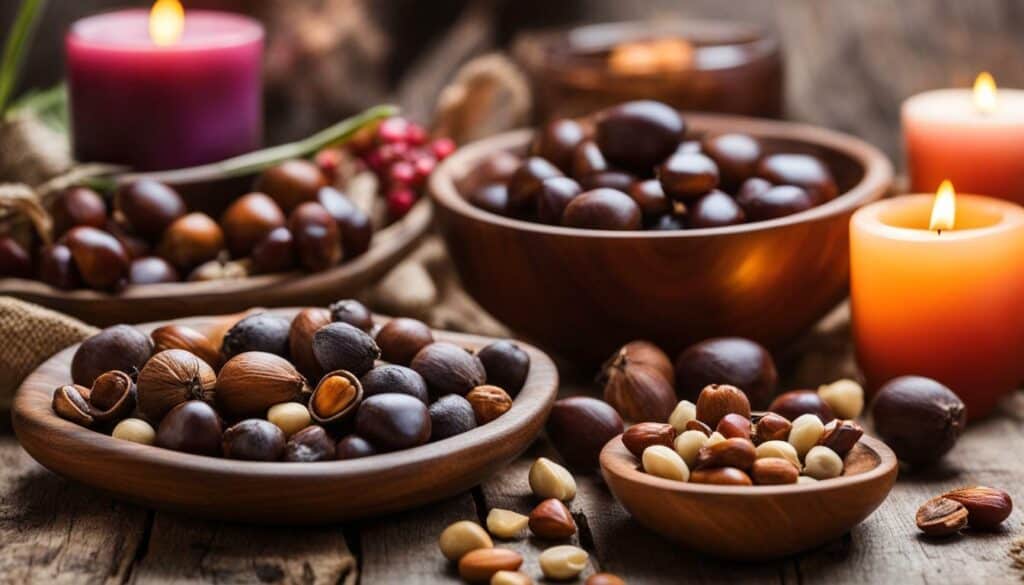
| Health Benefits of Candle Nuts | Uses of Candle Nut Oil in Skincare |
|---|---|
|
|
Using Candle Nuts Safely
To enjoy the benefits of candle nuts, it is essential to use them safely. Always ensure that candle nuts are roasted or cooked thoroughly before consumption. Avoid consuming them raw, as this can lead to potential toxicity and digestive issues. When using candle nut oil in skincare, perform a patch test before applying it to a larger area of the skin to check for any allergic reactions or sensitivities. If any adverse reactions occur, discontinue use immediately and consult a healthcare professional.
The Beauty Rituals of Candle Nuts
Beyond culinary delights, candle nut oil has made its way into the world of skincare, offering a range of benefits for a radiant complexion. This all-natural oil, derived from the candle nut tree, has long been treasured in Southeast Asian beauty rituals for its moisturizing and nourishing properties.
Rich in essential fatty acids and antioxidants, candle nut oil deeply hydrates the skin, leaving it soft and supple. Its lightweight texture ensures quick absorption, without leaving behind any greasy residue. Regular use of candle nut oil can help reduce the appearance of fine lines and wrinkles, and improve overall skin elasticity.
Furthermore, candle nut oil is known to protect the skin from environmental damage, thanks to its high vitamin E content. This powerful antioxidant shields the skin from free radicals and helps maintain a youthful glow. Whether used as a facial oil, body moisturizer, or hair treatment, candle nut oil provides an indulgent and rejuvenating experience.
| Benefits of Candle Nut Oil in Skincare: | How to Use Candle Nut Oil: |
|---|---|
|
|
Indulge in the beauty rituals of candle nuts and experience the transformative power of candle nut oil for yourself. Discover the natural wonders of Southeast Asian skincare traditions, enriched with the nourishing properties of this ancient ingredient. Embrace the radiance and beauty that candle nuts bring to your self-care routine.
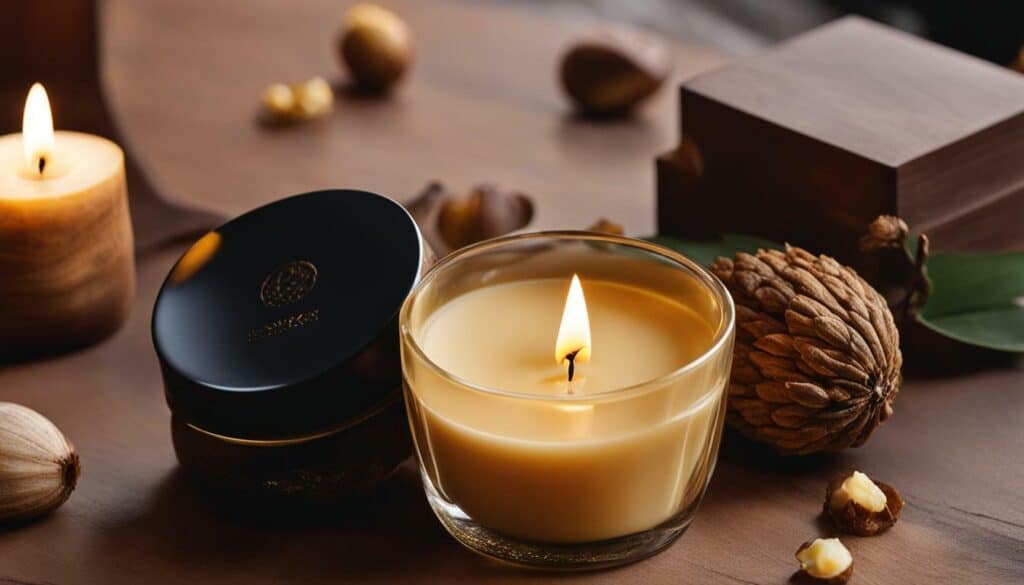
While candle nuts offer numerous benefits, it’s important to be aware of potential allergies and take necessary precautions. Some individuals may have an allergic reaction to candle nuts, resulting in symptoms such as itching, swelling, or difficulty breathing. If you have a known nut allergy, it’s advisable to avoid candle nuts or consult with a healthcare professional before incorporating them into your diet or skincare routine.
If you’re using candle nuts for cooking, it’s crucial to handle them properly. The shells of candle nuts contain saponins, a natural detergent that can cause irritation to the skin. To avoid any discomfort, always wear gloves when peeling or grinding candle nuts, and make sure to wash your hands thoroughly afterward. Additionally, be cautious when storing candle nuts, as their high oil content can cause them to turn rancid if not stored properly in an airtight container.
When it comes to skincare, it’s important to perform a patch test before using any product containing candle nut oil. Apply a small amount of the product to a small area of your skin and wait for 24 hours to check for any adverse reactions. If you experience any redness, itching, or irritation, discontinue use immediately and seek medical advice.
Common Candle Nut Allergy Symptoms:
- Itching or hives
- Swelling of the face, lips, tongue, or throat
- Difficulty breathing or wheezing
- Nausea or stomach cramps
Remember, while candle nuts can add a unique flavor to your dishes and provide moisturizing benefits to your skin, it’s essential to prioritize your safety and health. By being aware of potential allergies and taking necessary precautions, you can enjoy the magic of candle nuts without any unwanted side effects.
 Before candle nuts became a culinary delight, they were utilized in traditional candle making due to their abundant oil content. This made them a valuable ingredient for creating light sources in the past. The high oil content of candle nuts allowed for a slow and steady burn, making them ideal for long-lasting candles.
Before candle nuts became a culinary delight, they were utilized in traditional candle making due to their abundant oil content. This made them a valuable ingredient for creating light sources in the past. The high oil content of candle nuts allowed for a slow and steady burn, making them ideal for long-lasting candles.
 In traditional candle making, the oil from candle nuts was extracted by crushing and pressing the nuts. The extracted oil was then used to fuel the flame of the candle. The process involved carefully drying the nuts before extracting the oil, ensuring that the candles burned smoothly and emitted a warm and comforting glow.
The use of candle nuts in traditional candle making highlights the versatility and significance of these nuts in various aspects of life. From serving as a source of light to adding flavor to culinary creations, candle nuts have played a vital role in Southeast Asian cultures for centuries.
Aside from their use in traditional candle making, candle nuts have found their way into Southeast Asian cuisine, beauty rituals, and traditional medicine. These versatile nuts are often roasted and ground to thicken sauces, adding a rich and creamy texture to dishes.
In skincare, candle nut oil is highly regarded for its moisturizing and nourishing properties. It can be found in a wide range of beauty products, delivering hydration and promoting healthy-looking skin. JUARA’s Candlenut Body Creme and Candlenut Glow Body Oil are just some examples of the skincare products that harness the benefits of candle nut oil.
When cooking with candle nuts, they can also be substituted for macadamia nuts. This makes it easier for those who may not have access to candle nuts to still enjoy the unique flavors they bring to dishes. However, it is important to note that consuming candle nuts raw can be toxic. Therefore, they should always be roasted or cooked before consumption.
In conclusion, candle nuts have a rich history that extends beyond their culinary uses. From traditional candle making to skincare and cooking, their versatility and benefits are widely recognized. By understanding the various ways in which candle nuts can be utilized, we can appreciate the magic and beauty these nuts bring to our lives.
In traditional candle making, the oil from candle nuts was extracted by crushing and pressing the nuts. The extracted oil was then used to fuel the flame of the candle. The process involved carefully drying the nuts before extracting the oil, ensuring that the candles burned smoothly and emitted a warm and comforting glow.
The use of candle nuts in traditional candle making highlights the versatility and significance of these nuts in various aspects of life. From serving as a source of light to adding flavor to culinary creations, candle nuts have played a vital role in Southeast Asian cultures for centuries.
Aside from their use in traditional candle making, candle nuts have found their way into Southeast Asian cuisine, beauty rituals, and traditional medicine. These versatile nuts are often roasted and ground to thicken sauces, adding a rich and creamy texture to dishes.
In skincare, candle nut oil is highly regarded for its moisturizing and nourishing properties. It can be found in a wide range of beauty products, delivering hydration and promoting healthy-looking skin. JUARA’s Candlenut Body Creme and Candlenut Glow Body Oil are just some examples of the skincare products that harness the benefits of candle nut oil.
When cooking with candle nuts, they can also be substituted for macadamia nuts. This makes it easier for those who may not have access to candle nuts to still enjoy the unique flavors they bring to dishes. However, it is important to note that consuming candle nuts raw can be toxic. Therefore, they should always be roasted or cooked before consumption.
In conclusion, candle nuts have a rich history that extends beyond their culinary uses. From traditional candle making to skincare and cooking, their versatility and benefits are widely recognized. By understanding the various ways in which candle nuts can be utilized, we can appreciate the magic and beauty these nuts bring to our lives.
| Candle Nuts in Traditional Candle Making | The Versatility of Candle Nuts |
|---|---|
| Before candle nuts became a culinary delight, they were utilized in traditional candle making due to their abundant oil content. | Aside from their use in traditional candle making, candle nuts have found their way into Southeast Asian cuisine, beauty rituals, and traditional medicine. |
| In traditional candle making, the oil from candle nuts was extracted by crushing and pressing the nuts. | When cooking with candle nuts, they can also be substituted for macadamia nuts. |
| From serving as a source of light to adding flavor to culinary creations, candle nuts have played a vital role in Southeast Asian cultures for centuries. | Candle nut oil is highly regarded for its moisturizing and nourishing properties, making it a sought-after ingredient in skincare. |
Cooking Tips and Substitutes for Candle Nuts
If you’re eager to cook with candle nuts but need some guidance or a substitute, this section will provide helpful tips and options. Candle nuts, also known as kemiri, are a versatile ingredient used in a variety of Southeast Asian dishes. To prepare candle nuts for cooking, they are typically roasted and then ground into a paste or powder. This process enhances their nutty flavor and releases their natural oils which help to thicken sauces and add richness to dishes.
One popular way to use candle nuts in cooking is to incorporate them into sauces and curries. They are often blended with other ingredients such as garlic, shallots, and chili peppers to create a flavorful base. The candle nut paste can be added towards the end of cooking to allow its unique flavors to infuse into the dish.
If you don’t have candle nuts on hand, you can easily substitute them with macadamia nuts. Macadamia nuts have a similar creamy texture and subtle taste, making them an excellent alternative. Simply use the same quantity of macadamia nuts as you would candle nuts in your recipe. However, keep in mind that while candle nuts are typically roasted before use, macadamia nuts are usually used raw or lightly toasted.
Tasty Tip
To elevate your dishes even further, try frying or toasting the macadamia nuts before using them as a substitute for candle nuts. This will enhance their aroma and deepen their flavor, giving your recipe a delightful twist.
Whether you choose to use candle nuts or their macadamia nut alternative, remember that they should never be consumed raw. Raw candle nuts contain toxins that can be harmful if ingested. Always ensure that you have properly cooked or roasted candle nuts before incorporating them into your culinary creations. This way, you can enjoy the unique flavors and thickening properties that make candle nuts a beloved ingredient in Southeast Asian cuisine.

While candle nuts offer culinary and health benefits, it’s essential to understand the risks associated with consuming raw candle nuts. Raw candle nuts contain toxins known as saponins, which can be harmful to humans if ingested without proper processing. These toxins can irritate the gastrointestinal tract, leading to symptoms such as nausea, vomiting, and diarrhea.
To enjoy the flavors and benefits of candle nuts safely, it is crucial to ensure they are cooked or processed adequately. Roasting or boiling candle nuts can help remove the toxins and make them safe for consumption. It’s important to note that boiling is the most effective method of removing the toxins, as roasting may not eliminate them entirely.
“Consuming raw candle nuts can be toxic. It’s crucial to cook or process candle nuts properly to remove the toxins and enjoy them safely.” – Dr. Jane Roberts, Nutrition Specialist
In addition to the risks associated with raw consumption, it’s important to be aware of potential allergies to candle nuts. Some individuals may experience allergic reactions, ranging from mild itching or skin irritation to more severe symptoms such as difficulty breathing or anaphylaxis. If you have a known allergy to nuts, it’s advisable to consult with a healthcare professional before incorporating candle nuts into your diet or using candle nut products.
By understanding the potential risks and taking necessary precautions, you can safely enjoy the culinary delights and health benefits that candle nuts have to offer. Whether incorporated into mouthwatering recipes, used in skincare applications, or explored for their historical significance, candle nuts can truly add a touch of magic to various aspects of our lives.
Conclusion
Our exploration of candle nuts has revealed their magical qualities, from their culinary and health benefits to their historical uses and precautions. Candle nuts, also known as kemiri, are a versatile ingredient that has been used in Southeast Asian cuisine for centuries. They add a unique flavor and richness to dishes, and can be roasted and ground to create delicious sauces and marinades.
Beyond the kitchen, candle nuts have also found their way into traditional medicine and beauty rituals. The high oil content of candle nuts makes them a valuable ingredient in skincare products, providing moisturizing and nourishing properties. Skincare brands like JUARA have harnessed the power of candlenut oil in products such as the Candlenut Body Creme and Candlenut Glow Body Oil, offering luxurious pampering experiences.
However, it’s important to note that candlenuts should not be consumed raw, as they can be toxic. Roasting or cooking them thoroughly eliminates any potential risks. Additionally, for those who may not have access to candle nuts, macadamia nuts can be a suitable substitute in recipes.
Overall, candle nuts are a fascinating ingredient with a rich history and a wide range of uses. Whether you’re exploring Southeast Asian cuisine, embracing natural skincare, or simply experimenting in the kitchen, candle nuts offer a touch of magic and a world of flavors to enhance your culinary and self-care adventures.
FAQ
Q: What are candle nuts?
A: Candle nuts, also known as kemiri, are a versatile ingredient that has been used in Southeast Asian cuisine, traditional medicine, and beauty rituals for centuries.
Q: What are the skincare benefits of candle nuts?
A: Candlenut oil is used for its moisturizing properties in skincare. It can be found in products like JUARA’s Candlenut Body Creme and Candlenut Glow Body Oil.
Q: How are candle nuts used in cooking?
A: Candle nuts are often roasted and ground to thicken sauces in Southeast Asian cuisine. They can also be used as a substitute for macadamia nuts.
Q: Can candle nuts be consumed raw?
A: No, it’s important not to consume candle nuts raw as they can be toxic.
Q: Are there any precautions or allergy concerns with candle nuts?
A: Candle nut allergies are possible, so it’s important to be aware of any potential sensitivity. Additionally, always take precautions when handling and consuming candle nuts.
Q: Can candle nuts be used in traditional candle making?
A: Yes, candle nuts were once used in candle making due to their high oil content.
Q: What are some cooking tips and substitutes for candle nuts?
A: When cooking with candle nuts, they are often roasted and ground. If candle nuts are not available, macadamia nuts can be used as a substitute.
Are Red Fresh Dates Also Beneficial for Health?
Red fresh dates, commonly known as jujubes, are packed with numerous health benefits. These ruby-colored fruits are an excellent source of antioxidants and nutrients, promoting digestive health, boosting the immune system, and enhancing bone strength. With their sweet, caramel-like flavor and the extensive health benefits of red dates, incorporating them into your diet can contribute to a healthier lifestyle.

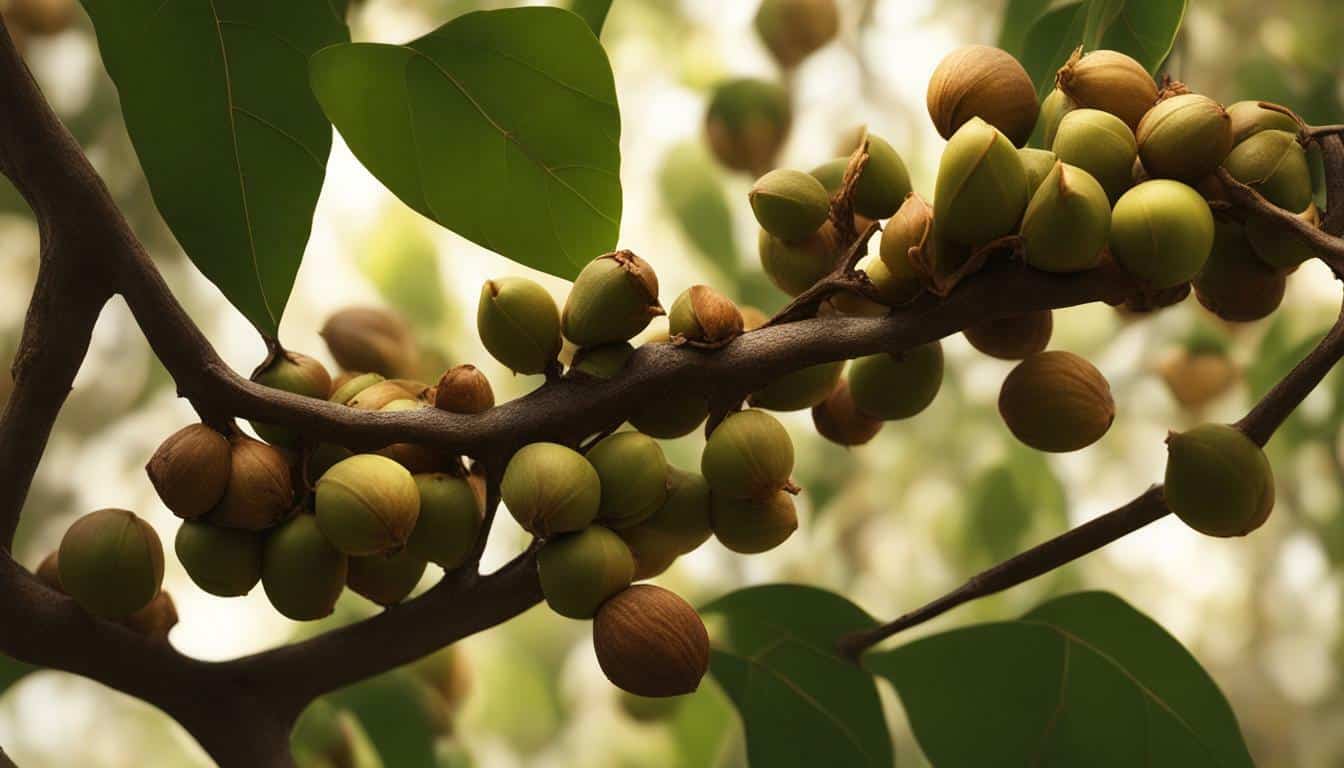
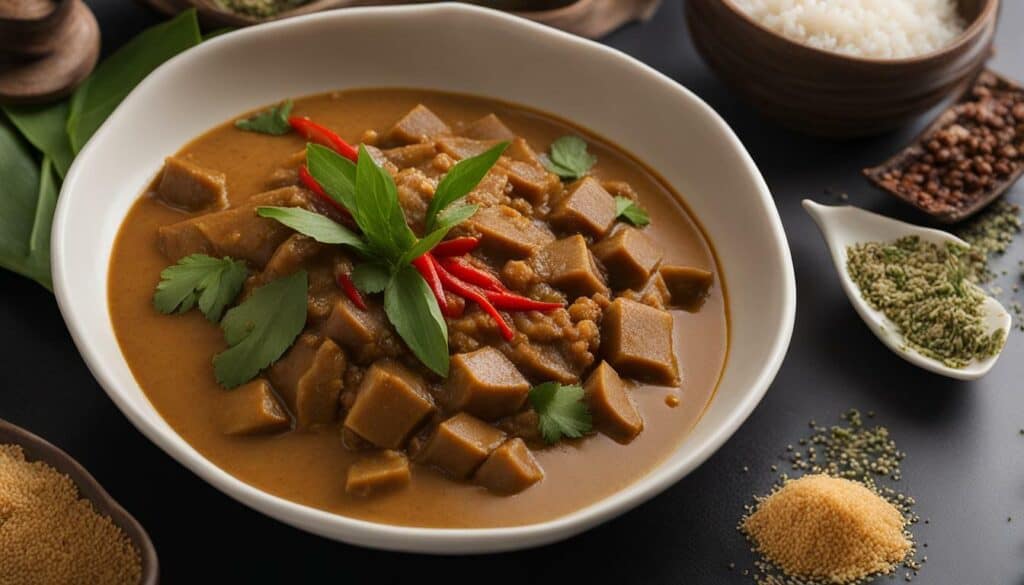
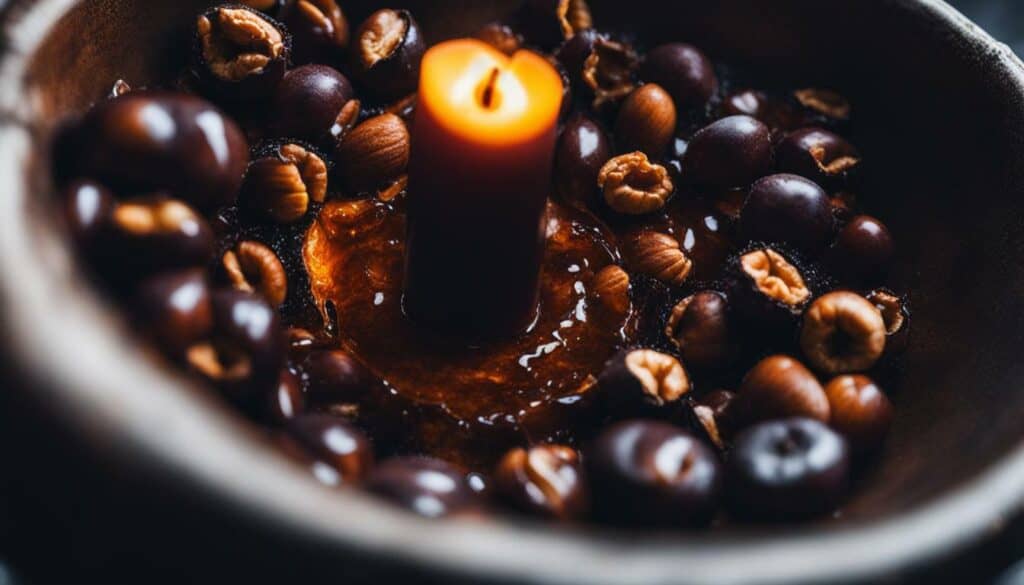



Leave a Reply